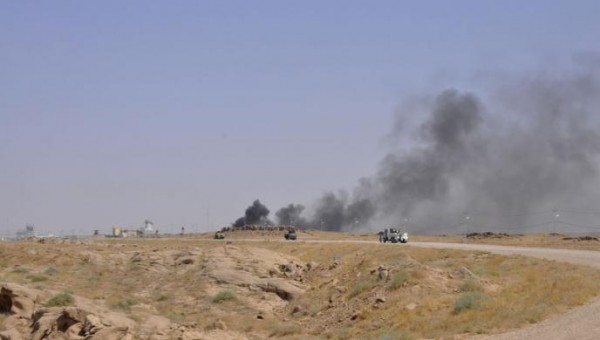ISIS Rebels Target 2nd Iraq Dam
| Andy Vitalicio | | Aug 06, 2014 10:29 PM EDT |
(Photo : Reuters) Smoke rises from an encounter site where Iraqi forces had just battled with ISIS militants in the northern deserts of Iraq.
Islamic state fighters in Iraq are targeting another critical dam, as fighting continues between the militants and Kurdish security forces near Mosul Dam, considered Iraq's largest.
As of Wednesday, Baghdad said government forces are in control of Mosul Dam, preventing a catasthropic event after the ISIS threatened to blow up the dam and flood a large area of Iraq's Nineveh province, including the city of Mosul which remained in rebel hands.
Like Us on Facebook
ISIS fighters reportedly were able to reach a housing facility for dam workers, but Peshmerga forces composed of Iraqi Kurds forced them out before they could do further damage.
About 350 kilometers to the south, Iraqi army troops clashed with ISIS militants in the villages near the Haditha Dam, on the Euphrates River in Anbar province northwest of Baghdad.
Arab News in Saudi Arabia interviewed Hameed Hashim, member of the Anbar provincial council, who said ISIS fighters have intensified their attacks on Haditha town and the dam in the last four days.
"Haditha dam is still under government forces' control and there are military reinforcements around it," Hashim said.
Even so, Iraq has to double security around the two big dams.
In 2007, a Pentagon report warned that the Mosul Dam, if breached through an act of sabotage, or even by accident, could send a 20-meter high flood wave through the city of Mosul and surrounding areas.
Analysts warned the ISIS could use the dam, and the Haditha Dam as well, as an instrument of environmental warfare - or more specifically dam warfare - if these fell into rebel hands.
Dam warfare was used on Germany's reservoirs in World War II, when British warplanes destroyed dams on the Mohne and Eder, and flooded 50 square miles of the Ruhr Valley industrial heartland in 1943, killing 1,300 people.
In China, the Nationalist Chinese Army blew up a key dike on the Yellow River in 1938 to block Japanese invaders on their advance to the important city of Wuhan. Chiang Kai-Shek knew full well that it would cause a big flood in central China.
Official estimates then said more than 800,000 Chinese civilians drowned and millions more were forced to flee.
The Japanese suffered only minimal casualties and took Wuhan after three months.
©2015 Chinatopix All rights reserved. Do not reproduce without permission
EDITOR'S PICKS
-

Did the Trump administration just announce plans for a trade war with ‘hostile’ China and Russia?
-

US Senate passes Taiwan travel bill slammed by China
-

As Yan Sihong’s family grieves, here are other Chinese students who went missing abroad. Some have never been found
-

Beijing blasts Western critics who ‘smear China’ with the term sharp power
-

China Envoy Seeks to Defuse Tensions With U.S. as a Trade War Brews
-

Singapore's Deputy PM Provides Bitcoin Vote of Confidence Amid China's Blanket Bans
-

China warns investors over risks in overseas virtual currency trading
-

Chinese government most trustworthy: survey
-

Kashima Antlers On Course For Back-To-Back Titles
MOST POPULAR
LATEST NEWS
Zhou Yongkang: China's Former Security Chief Sentenced to Life in Prison

China's former Chief of the Ministry of Public Security, Zhou Yongkang, has been given a life sentence after he was found guilty of abusing his office, bribery and deliberately ... Full Article
TRENDING STORY

China Pork Prices Expected to Stabilize As The Supplies Recover

Elephone P9000 Smartphone is now on Sale on Amazon India

There's a Big Chance Cliffhangers Won't Still Be Resolved When Grey's Anatomy Season 13 Returns

Supreme Court Ruled on Samsung vs Apple Dispute for Patent Infringement

Microsoft Surface Pro 5 Rumors and Release Date: What is the Latest?










